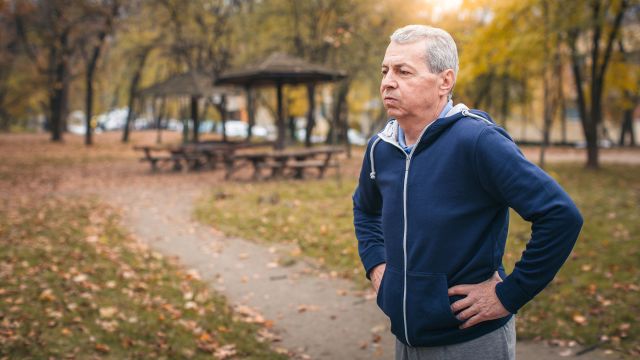Chronic obstructive pulmonary disease (COPD) is a term that describes a few types of lung disease—most notably emphysema and chronic bronchitis—that worsen over time. Most people with the condition experience symptoms that include:
- Chronic cough, which may be intermittent (occasional) or unproductive
- Shortness of breath (dyspnea) that is persistent, progressive, and typically worsens with exercise
- Chronic production of sputum
Every patient’s experience with COPD is different. Some lifestyle habits (like smoking) can lead to a more rapid progression of the condition, while others (like high-intensity exercise) can help slow the decline of lung function. There’s no cure for COPD, but there are steps you can take to treat and manage the condition, avoid potential complications, and improve your quality of life.
COPD medications
Once you’re diagnosed with COPD, your healthcare provider (HCP) will work with you to decide which treatment options can best help manage your symptoms. These may include the following:
Bronchodilators help relax the muscles around your airways to make breathing easier. Most are administered with an inhaler or a nebulizer so that you breathe the medication directly into your lungs. Depending on the severity of your COPD, your HCP may prescribe:
- Short-acting bronchodilators: These are taken when you need quick relief from COPD symptoms. The effects of these medications wear off within a few hours.
- Long-acting bronchodilators: These work more slowly but provide relief lasting for 12 to 24 hours.
There are two specific types of bronchodilators, and either one can be a short-acting medication or a long-acting medication. These include:
- Beta-agonists: These relax tightened muscles around your airways to make breathing easier.
- Anticholinergics: These prevent airway muscles from contracting while helping to clear mucus from the lungs.
Combination medications contain a mix of two or three COPD medications: a beta-agonist, an anticholinergic, and a corticosteroid medication. In general, using inhaled steroids alone is not a preferred COPD treatment. If your COPD is more severe, or if your symptoms flare up often, your HCP may prescribe a combination of medicines that includes a bronchodilator and an inhaled steroid.
Be sure to work closely with your HCP on how to administer your COPD medication, as various inhalers and nebulizers work differently. If you have any questions about how to properly take your medication, bring your inhaler to your next HCP appointment. Improper use of treatment devices may result in not getting the right amount of medication.
Additional COPD treatments
Medication alone often isn’t enough to properly manage COPD. Your HCP may recommend one or more of these additional therapies:
Pulmonary rehabilitation is an outpatient group program where you can learn more about managing your COPD. Led by various medical professionals, pulmonary rehab can help you gain the skills you need to increase fitness levels, improve lung function, and perform daily activities. It also gives you the opportunity to meet and connect with others who are managing COPD.
Supplemental oxygen may be recommended for patients with severe cases of COPD who have chronically low levels of oxygen in the blood as a result of the disease. In certain patients, it can help improve quality of life.
Surgery is often used as a last resort, but it’s an option for some people who have severe COPD that isn’t improving with the use of medications and other therapies. Surgical interventions include:
- Bullectomy: This procedure removes bullae, which are large air spaces that result when the lungs’ air sacs are destroyed. These can interfere with your breathing if left untreated.
- Lung volume reduction: This surgery removes damaged tissue from the lungs to improve lung function.
- Lung transplant: During this procedure, the damaged lung is replaced with a healthy donor lung.
Lifestyle changes for COPD management
In addition to your treatment plan, your HCP will also likely recommend you make certain lifestyle changes, which include the following:
Quit smoking. If you smoke, kicking the habit is the most important step you can take to slow the progress of the disease and improve symptoms. If you have trouble quitting, talk to your HCP about using smoking cessation aids.
Stay active. COPD can hinder breathing, which often makes exercise a challenge. But staying active when you have COPD can strengthen the muscles that help you breathe, which in turn can help improve symptoms. Ask your HCP about COPD-friendly activities to try, such as walking, biking, or swimming.
Make sure you get good nutrition. This is especially important if you have trouble eating due to shortness of breath or fatigue related to COPD. If dietary supplementation would make sense in your case, your HCP can provide strategies for getting the calories and nutrients your body needs to stay healthy. Strategies may include eating smaller meals more frequently, resting before you eat, and taking nutritional supplements.
Prevent illness. Taking steps to avoid lung infections is an important part of COPD management. Your HCP will likely recommend getting an annual flu shot as well as getting vaccinated for pneumonia and COVID-19. It’s also helpful to wash your hands regularly and avoid interactions with others who are sick. Your HCP may even preemptively prescribe antibiotics or antiviral medications to keep on hand in case you come down with an infection.
Pay attention to air quality. Take steps to reduce allergens in your home such as dust mites and pet dander, which can trigger COPD symptoms. Avoid secondhand smoke and other irritating fumes at home and elsewhere. You can check the air quality index for outdoor pollution before leaving your home and adjust your plans to avoid spending prolonged periods outside on days with poor air quality.
Consider complementary therapy. Some people benefit from adding therapies such as massage, acupuncture, or meditation to their COPD management plan. These approaches may help ease pain and side effects, reduce the anxiety that often comes with the disease, and improve overall quality of life. Before you try any type of complementary therapy, consult with your HCP.
Putting it all together
Everyone’s COPD is different, so be sure to work with your HCP to discuss what to include in your management plan. Once you have your strategy in place, sticking to it is essential.
If your symptoms worsen despite following your plan, check with your HCP, as this may be a sign that you’d benefit from a change in COPD treatment. Always be on the lookout for a COPD exacerbation—when your symptoms suddenly become worse, typically as a result of an infection—which will require prompt treatment and possibly hospitalization.







